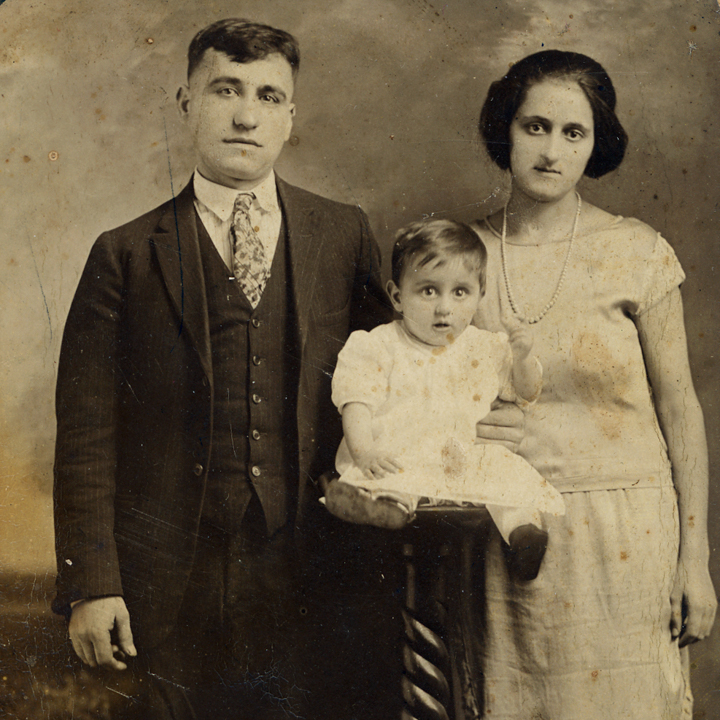Bedoian/Abrahamian
Katchadoor Bedoian was born in 1896 in Bazmashen, Kharpert a farming village in the Kharpert province in historic Western Armenia. Katchadoor’s father had died at the early age of 45; his mother Mariam remarried to a man who had two sons. Knowing he would soon be drafted into the Turkish army, Katchadoor sailed to America with his cousin Moses Mantashigian and Moses’ father Malkas, leaving behind his mother and a 14-year-old red-haired brother named Harootiun. Katchadoor’s hope for this journey was to work in a factory in America and to return to Armenia with some money. Neither Katchadoor nor his family could foresee the genocide that would unfold months later – a genocide that would force the family he left behind to march to their deaths in the Syrian desert.
With his cousin and uncle, Katchadoor arrived in Ellis Island, New York and traveled on to Whitinsville where other villagers from Bazmashen had settled. Katchadoor found work at the Whitin Machine Works and lived on Border Street in New Village, boarding with the Machoian family. As the Armenians in Whitinsville learned about the massacres and deportation marches that destroyed their homeland, they knew that there could be no return to the Armenia they had left. In 1922, Katchadoor left the United States and traveled to Smyrna. Upon arrival he asked a woman he met – Varvara Abrahamian -- where he could find the Armenian church, and she invited him to her home where he met his future wife, Siranoush Abrahamian.
Siranoush Abrahamian was born in 1906 to Varvara Haroutunian Abrahamian. At the time Katchadoor arrived in Smyrna, Varvara was a widow; Turkish soldiers had arrived one night, taken her husband and killed him. Varvara insisted that Katchadoor and Siranoush marry before he left for America. Not long after Katchadoor left his new wife and mother-in-law in Smyrna, the Turkish army reached the city, looking to control the strategic seaport. Varvara and Siranoush, along with other Armenians and Greeks, fled their homes and headed to the seaport, looking for a way out. Smyrna was burning. When they arrived at the port, the Turkish soldiers were ripping the gold necklaces from the Armenian women. In the seaport were British and French ships along with one from Japan. The British and French would not allow the desperate refugees to board their ships, but the captain of the ship from Japan told his crew to accept the refugees, including Varvara and Siranoush. They were brought to Athens, Greece where they would join thousands of other desperate refugees. For one year, Varvara and Siranoush were only able to eat by foraging in garbage cans. By 1924, Katchadoor had located them and had saved enough money for their passage to America. Siranoush joined Katchadoor in America in June 1924, arriving in Providence and then traveling on to Whitinsville.
Katchadoor, now known by his adopted American name Archie, lived with his wife Siranoush, now known as Sarah in Whitinsville. Their family grew with the birth of their oldest son, John, in 1925 (who later moved to Pennsylvania), followed by Harry in 1929, Michael in 1935, and Mary in 1941. Katchadoor continued to work at the Whitin Machine Works and rented a home for his family in one of the tenements built by the Whitin Machine Works for their workers on North Main Street. These homes were heated by wood burning stoves.
In 1948, Archie approached Frank Morrison, a lawyer with offices in the Whitinsville Savings Bank building, about purchasing a lot from which he could cut wood to heat his home. He gave Katchadoor an address of a man in Worcester who owned land in Sutton and Uxbridge. The man was 80 years old and wanted to sell the land; that man sold Katchadoor the land and gave him a map to locate it. As Katchadoor could not read or write in English, Harry took the map and found the land his father had purchased. Although he never went to college, Harry’s business acumen and interest in civil engineering helped him see the potential in this land far beyond wood to keep the home warm.
Siranoush died in 1958 and is buried in Pine Grove Cemetery; Katchadoor lived another 8 years and is buried with Siranoush.
As years went by, Harry bought more land adjacent to his father’s land and started a gravel business. Mary worked in the office there, learning the business from her brother and serving as caregiver for her other brother Michael who had developed schizophrenia. When Harry died in 1993, Mary took over running the business which continued to operate successfully. After Michael died in 2015, Mary started planning for the sale of the land and business which was completed in 2021. With the proceeds from the sale of the land and business, Mary has made generous donations to Armenian American institutions, including Soorp Asdvadzadzin church in Whitinsville.

